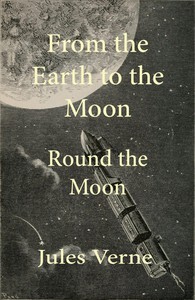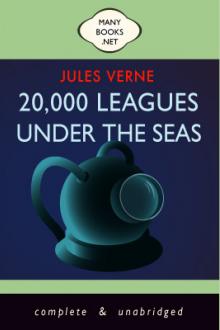The Moon-Voyage by Jules Verne (mobi ebook reader .txt) 📖

- Author: Jules Verne
Book online «The Moon-Voyage by Jules Verne (mobi ebook reader .txt) 📖». Author Jules Verne
Observatory of Cambridge in the name of the members of the Baltimore
Gun Club, we immediately called a meeting of our staff, who have deemed
it expedient to answer as follows:—
"The questions proposed to it were these:—
"'1. Is it possible to send a projectile to the moon?
"'2. What is the exact distance that separates the earth and her satellite?
"'3. What would be the duration of the projectile's transit to which a sufficient initial speed had been given, and consequently at what moment should it be hurled so as to reach the moon at a particular point?
"'4. At what moment would the moon present the most favourable position for being reached by the projectile?
"'5. What point in the heavens ought the cannon, destined to hurl the projectile, be aimed at?
"'6. What place in the heavens will the moon occupy at the moment when the projectile will start?'
"Regarding question No. 1, 'Is it possible to send a projectile to the moon?'
"Yes, it is possible to send a projectile to the moon if it is given an initial velocity of 1,200 yards a second. Calculations prove that this speed is sufficient. In proportion to the distance from the earth the force of gravitation diminishes in an inverse ratio to the square of the distance—that is to say, that for a distance three times greater that force is nine times less. In consequence, the weight of the projectile will decrease rapidly, and will end by being completely annulled at the moment when the attraction of the moon will be equal to that of the earth—that is to say, at the 47/52 of the distance. At that moment the projectile will have no weight at all, and if it clears that point it will fall on to the moon only by the effect of lunar gravitation. The theoretic possibility of the experiment is, therefore, quite demonstrated; as to its success, that depends solely in the power of the engine employed.
"Regarding question No. 2, 'What is the exact distance that separates the earth from her satellite?'
"The moon does not describe a circle round the earth, but an ellipse, of which our earth occupies one of the foci; the consequence is, therefore, that at certain times it approaches nearer to, and at others recedes farther from, the earth, or, in astronomical language, it has its apogee and its perigee. At its apogee the moon is at 247,552 miles from the earth, and at its perigee at 218,657 miles only, which makes a difference of 28,895, or more than a ninth of the distance. The perigee distance is, therefore, the one that should give us the basis of all calculations.
"Regarding question No. 3, 'What would be the duration of the projectile's transit to which a sufficient initial speed has been given, and consequently at what moment should it be hurled so as to reach the moon at a particular point?'
"If the projectile kept indefinitely the initial speed of 12,000 yards a second, it would only take about nine hours to reach its destination; but as that initial velocity will go on decreasing, it will happen, everything calculated upon, that the projectile will take 300,000 seconds, or 83 hours and 20 minutes, to reach the point where the terrestrial and lunar gravitations are equal, and from that point it will fall upon the moon in 50,000 seconds, or 13 hours, 53 minutes, and 20 seconds. It must, therefore, be hurled 97 hours, 13 minutes, and 20 seconds before the arrival of the moon at the point aimed at.
"Regarding question No. 4, 'At what moment would the moon present the most favourable position for being reached by the projectile?'
"According to what has been said above the epoch of the moon's perigee must first be chosen, and at the moment when she will be crossing her zenith, which will still further diminish the entire distance by a length equal to the terrestrial radius—i.e., 3,919 miles; consequently, the passage to be accomplished will be 214,976 miles. But the moon is not always at her zenith when she reaches her perigee, which is once a month. She is only under the two conditions simultaneously at long intervals of time. This coincidence of perigee and zenith must be waited for. It happens fortunately that on December 4th of next year the moon will offer these two conditions; at midnight she will be at her perigee and her zenith—that is to say, at her shortest distance from the earth and at her zenith at the same time.
"Regarding question No. 5, 'At what point in the heavens ought the cannon destined to hurl the projectile be aimed?'
"The preceding observations being admitted, the cannon ought to be aimed at the zenith of the place (the zenith is the spot situated vertically above the head of a spectator), so that its range will be perpendicular to the plane of the horizon, and the projectile will pass the soonest beyond the range of terrestrial gravitation. But for the moon to reach the zenith of a place that place must not exceed in latitude the declination of the luminary—in other words, it must be comprised between 0° and 28° of north or south latitude. In any other place the range must necessarily be oblique, which would seriously affect the success of the experiment.
"Regarding question No. 6, 'What place will the moon occupy In the heavens at the moment of the projectile's departure?'
"At the moment when the projectile is hurled into space, the moon, which travels forward 13° 10' 35" each day, will be four times as distant from her zenith point—i.e., by 52° 42' 20", a space which corresponds to the distance she will travel during the transit of the projectile. But as the deviation which the rotatory movement of the earth will impart to the shock must also be taken into account, and as the projectile cannot reach the moon until after a deviation equal to sixteen radii of the earth, which, calculated upon the moon's orbit, is equal to about 11°, it is necessary to add these 11° to those caused by the already-mentioned delay of the moon, or, in round numbers, 64°. Thus, at the moment of firing, the visual radius applied to the moon will describe with the vertical line of the place an angle of 64°.
"Such are the answers to the questions proposed to the Observatory of
Cambridge by the members of the Gun Club.
"To sum up—
"1st. The cannon must be placed in a country situated between 0° and 28° of north or south latitude.
"2nd. It must be aimed at the zenith of the place.
"3rd. The projectile must have an initial speed of 12,000 yards a second.
"4th. It must be hurled on December 1st of next year, at 10hrs. 46mins. 40secs. p.m.
"5th. It will meet the moon four days after its departure on December 4th, at midnight precisely, at the moment she arrives at her zenith.
"The members of the Gun Club ought, therefore, at once to commence the labour necessitated by such an enterprise, and be ready to put them into execution at the moment fixed upon, for they will not find the moon in the same conditions of perigee and zenith till eighteen years and eleven days later.
"The staff of the Observatory of Cambridge puts itself entirely at their disposition for questions of theoretic astronomy, and begs to join its congratulations to those of the whole of America.
"On behalf of the staff,
"J.M. BELFAST,"Director of the Observatory of Cambridge."
CHAPTER V. THE ROMANCE OF THE MOON.A spectator endowed with infinite power of sight, and placed at the unknown centre round which gravitates the universe, would have seen myriads of atoms filling all space during the chaotic epoch of creation. But by degrees, as centuries went on, a change took place; a law of gravitation manifested itself which the wandering atoms obeyed; these atoms, combined chemically according to their affinities, formed themselves into molecules, and made those nebulous masses with which the depths of the heavens are strewed.
These masses were immediately animated by a movement of rotation round their central point. This centre, made of vague molecules, began to turn on itself whilst progressively condensing; then, following the immutable laws of mechanics, in proportion as its volume became diminished by condensation its movement of rotation was accelerated, and these two effects persisting, there resulted a principal planet, the centre of the nebulous mass.
By watching attentively the spectator would then have seen other molecules in the mass behave like the central planet, and condense in the same manner by a movement of progressively-accelerated rotation, and gravitate round it under the form of innumerable stars. The nebulae, of which astronomers count nearly 5,000 at present, were formed.
Amongst these 5,000 nebulae there is one that men have called the Milky Way, and which contains eighteen millions of stars, each of which has become the centre of a solar world.
If the spectator had then specially examined amongst these eighteen millions of stars one of the most modest and least brilliant, a star of the fourth order, the one that proudly named itself the sun, all the phenomena to which the formation of the universe is due would have successively taken place under his eyes.
In fact, he would have perceived this sun still in its gaseous state, and composed of mobile molecules; he would have perceived it turning on its own axis to finish its work of concentration. This movement, faithful to the laws of mechanics, would have been accelerated by the diminution of volume, and a time would have come when the centrifugal force would have overpowered the centripetal, which causes the molecules all to tend towards the centre.
Then another phenomenon would have passed before the eyes of the spectator, and the molecules situated in the plane of the equator would have formed several concentric rings like that of Saturn round the sun. In their turn these rings of cosmic matter, seized with a movement of rotation round the central mass, would have been broken up into secondary nebulae—that is to say, into planets.
If the spectator had then concentrated all his attention on these planets he would have seen them behave exactly like the sun and give birth to one or more cosmic rings, origin of those secondary bodies which we call satellites.
Thus in going up from the atom to the molecule, from the molecule to the nebulae, and from the nebulae to the principal star, from the principal star to the sun, from the sun to the planet, and from the planet to the satellite, we have the whole series of transformations undergone by the celestial powers from the first days of the universe.
The sun seems lost amidst the immensities of the stellar universe, and yet it is related, by actual theories of science, to the nebula of the Milky Way. Centre of a world, and small as it appears amidst the ethereal regions, it is still enormous, for its size is 1,400,000 times that of the earth. Around it gravitate eight planets, struck off from its own mass in the first days of creation. These are, in proceeding from the nearest to the most distant, Mercury, Venus, the Earth, Mars, Jupiter, Saturn, Uranus, and Neptune. Between Mars and Jupiter circulate regularly other smaller bodies, the wandering débris, perhaps, of a star broken up into thousands of pieces, of which the telescope has discovered eighty-two at present. Some of these asteroids are so small that they could be walked round in a single day by going at a gymnastic pace.
Of these attendant bodies which the sun maintains in their elliptical orbit by the great law of gravitation, some possess satellites of their own. Uranus has eight, Saturn eight, Jupiter four, Neptune three perhaps, and the Earth one; this latter, one of the least important of the solar world, is called the Moon, and it is that one that the enterprising genius of the Americans means to conquer.
The Queen of Night, from her relative proximity and the spectacle rapidly renewed of her different phases, at first divided the attention of the inhabitants of the earth with the sun; but the sun tires the eyesight, and the splendour of its light forces its admirers to lower their eyes.
The blonde Phoebe, more humane, graciously allows herself to be seen in her modest grace; she is gentle to the eye, not ambitious, and yet she sometimes eclipses her brother the radiant Apollo, without ever being eclipsed by him. The Mahommedans understood what gratitude they owed to this faithful friend of the earth, and they ruled their months at 29-1/2 days on her revolution.
The first
 Have you ever thought about what fiction is? Probably, such a question may seem surprising: and so everything is clear. Every person throughout his life has to repeatedly create the works he needs for specific purposes - statements, autobiographies, dictations - using not gypsum or clay, not musical notes, not paints, but just a word. At the same time, almost every person will be very surprised if he is told that he thereby created a work of fiction, which is very different from visual art, music and sculpture making. However, everyone understands that a student's essay or dictation is fundamentally different from novels, short stories, news that are created by professional writers. In the works of professionals there is the most important difference - excogitation. But, oddly enough, in a school literature course, you don’t realize the full power of fiction. So using our website in your free time discover fiction for yourself.
Have you ever thought about what fiction is? Probably, such a question may seem surprising: and so everything is clear. Every person throughout his life has to repeatedly create the works he needs for specific purposes - statements, autobiographies, dictations - using not gypsum or clay, not musical notes, not paints, but just a word. At the same time, almost every person will be very surprised if he is told that he thereby created a work of fiction, which is very different from visual art, music and sculpture making. However, everyone understands that a student's essay or dictation is fundamentally different from novels, short stories, news that are created by professional writers. In the works of professionals there is the most important difference - excogitation. But, oddly enough, in a school literature course, you don’t realize the full power of fiction. So using our website in your free time discover fiction for yourself. 




Comments (0)